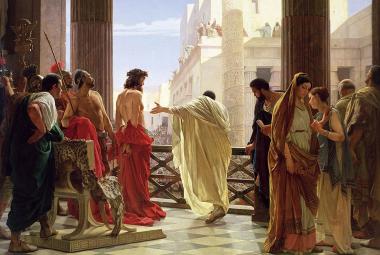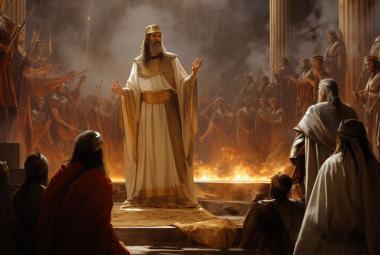The anti-Semitism of the early Church is one of the great tragedies of history. While the teachings of Jesus came straight from the Hebrew Scriptures, a backlash against ritualistic devotion to the Law developed into a deliberate attempt to steer away from the Old Testament. Tensions with the Jews led to severe persecution as the Church became a dominant political institution during subsequent centuries. A wedge was driven between Jews and Christians, although both worshipped the God of Abraham, Isaac, and Jacob. Jewish communities developed a staunch resistance to Jesus as the Messiah, and Christians lost the richness of Jewish history and prophecy, the very foundations of faith in Jesus Christ.
As Christians, we need to understand our Jewish roots. Many of the teachings of Christianity take on deeper insight and meaning when we understand them in a Jewish context, and few places is this more clear than in a study of the feasts of Israel. The seven Feasts of Moses are not only commemorative historically as they are observed in Judaism, but every detail of these seven feasts are anticipatory of the person and mission and achievement of the Messiah.
Every Jot and Tittle
The great discovery in my life has been the realization that every detail in the Scriptures is there by supernatural engineering. Every number, every location, name, even implied punctuation is there by design. The Bible contains 66 books by 40 authors, and yet the entire volume is an integrated message system. Once you discover that, you have a whole new appreciation for why God puts His Word even above His own name.1
The feasts of the Torah were directly dictated by God to Moses with a greater purpose than to give the Hebrews an occasional day off throughout the year. These feasts are still venerated in modern Judaism — Jews observe them, even to this day and they are very sensitive to their heritage. The ancient Hebrews called the feasts of Israel “the Appointed Times,” and the Jewish calendar offers many treasures to New Testament Christians even today. The Law itself is our tutor.
Jesus emphasizes the prophetic importance of the Law when He tells the Jews, “For had ye believed Moses, ye would have believed me: for he wrote of me. But if ye believe not his writings, how shall ye believe my words?”2
We might expect Jesus to fulfill the words of the prophetic books of the Bible, but Jesus makes it clear that He came to satisfy the words of the Law as well. The very Torah, the five books of Moses down to every last little dot, tells us about the Messiah.
In Matthew 5:17–18, Jesus assures His disciples, “Think not that I am come to destroy the law, or the prophets: I am not come to destroy, but to fulfill. For verily I say unto you, Till heaven and earth pass, one jot or one tittle shall in no wise pass from the law, till all be fulfilled.”
The smallest letter in the Hebrew language, a jot (or yod) looks like an apostrophe, hardly more than a little scratch. Tittles are the tiny decorative hooks on letters. In other words, Jesus declares that every detail of the Hebrew Scriptures is important, down to the tiniest letters and marks. If He were speaking in English, He might have said, “Not one crossing of a ’t’ or dotting of an ‘i’ will pass from the law till all be fulfilled.”
This is one of the reasons we’re so intrigued with a rabbinical viewpoint that says the rabbis won’t really understand the Torah until the Messiah comes; but when He comes He will not only interpret the passages, He’ll interpret the very words, He’ll even interpret the very letters. In fact, He’ll even interpret the spaces between the letters. A colorful exaggeration until one considers the verse above where Jesus Himself implies that the very parts of the letters are, in effect, sacred.
The Old Testament is not merely a collection of Jewish history and law; it is God’s message of salvation to a fallen humanity. Paul picks up on this when he says in Romans 15:4: “For whatsoever things were written aforetime were written for our learning, that we through patience and comfort of the scriptures might have hope.”
The ultimate commentary of the Bible is the Bible itself. “And whatsoever things were written aforetime…” Paul says, referring to all the ancient texts of the Old Testament, all of them in one sweep, “were written for our learning…”
Something Hidden
St. Augustine famously highlighted, “In the Old Testament the New Testament is concealed; in the New Testament the Old Testament is revealed.” Each is incomplete without the other. But the message of salvation isn’t necessarily clear at first skim through the Old Testament. As Hosea 12:10 says: “I have spoken by the prophets, and I have multiplied visions and used similitudes, by the ministry of the prophets.”
A similitude is a figure of speech that describes something by likening it to another. Before we dig into the feasts themselves, it is important to understand the various ways that the Bible communicates. A great many prophetic ideas are not directly explained; they are developed in a deeper way through repeated actions and visual pictures and culture. We find many examples of similitudes in the Bible in the forms of similes, metaphors, allegories, parables, and prophetic types.
Similes are a familiar form of expression used to compare one thing with another. Rather than merely calling Jack’s feet “cold,” we might elaborate and say, “Jack’s feet felt like blocks of ice.” The Psalmist groans in Psalm 22:14, declaring, “I am poured out like water… my heart is like wax…”
Metaphors offer comparisons without saying, “like” or “as.” That is, “Jack’s feet were blocks of ice.” In Psalm 22:14, the writer says of his heart: “…it is melted in the midst of my bowels.” His heart isn’t actually physically melted like wax; he is using the metaphor to describe his current suffering.
Hypocatastasis is an implied resemblance that avoids naming the described thing at all. “Jack walked on blocks of ice.” In 1 Corinthians 13:12, Paul describes our current spiritual dim-sightedness when he says, “For now we see through a glass, darkly…”
Parables are short stories that represent an idea by comparison. They create symbolic pictures in the imaginations of the hearers. “For the kingdom of heaven is like unto a man that is an householder, which went out early in the morning to hire labourers into his vineyard…”3 Parables teach a simple message or lesson.
Allegories are like extended parables, long stories with multiple symbolic parts that teach meaning. The tale of Pinocchio is an allegory about the struggle to choose right over wrong. When Pinocchio fibs repeatedly, his nose stretches and grows leaves to represent the reality that, “A lie keeps growing and growing until it’s as plain as the nose on your face.” When the boys go wild on Pleasure Island, they all begin to sprout donkey ears and tails and hooves and faces, representing the jackasses they have all made of themselves.
Types are often used in the Bible to foreshadow a person or event that has great future importance. The name “Jesus” is a variation of the Hebrew name “Joshua,” which means “Yahweh is salvation.” As Moses’ successor, Joshua became a type of Jesus in many ways — as the captain of the armies of Israel, as one who leads his people into the Promised Land and gives them rest.
These are some of the more common figures of speech, but in an appendix to our book, Cosmic Codes, we list more than 200 that are used throughout Scripture.4 Because types are such an important prophetic tool in the Bible, we will look into their use here in more depth.
This excerpt is from Dr. Chuck Missler’s book The Feasts of Israel, available as paperback and eBook from the K-House Store. Also available in Kindle format from Amazon.
Notes:
- Psalm 138:2 ↩
- John 5:46–47 ↩
- Matthew 20:1–16 ↩
- Missler, Chuck. Appendix A, Cosmic Codes. Koinonia House: Post Falls, ID ↩






